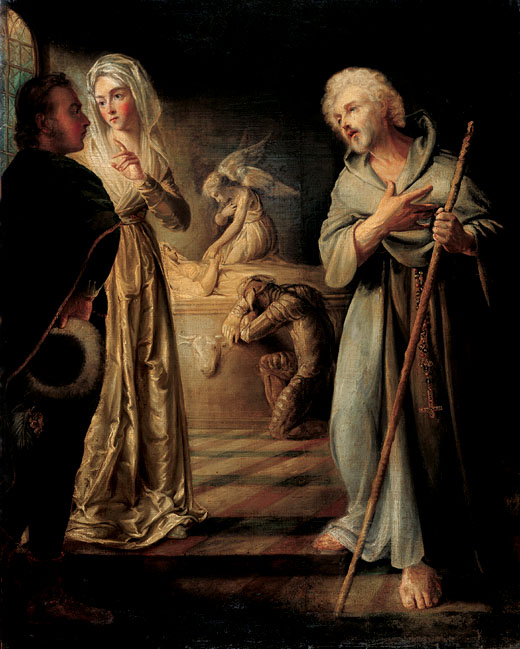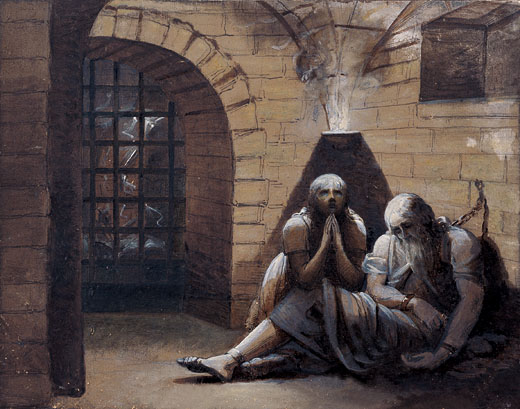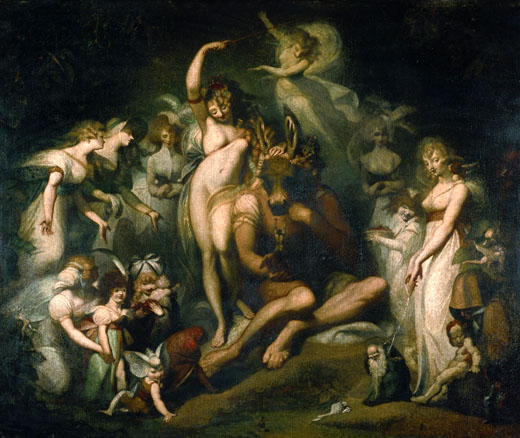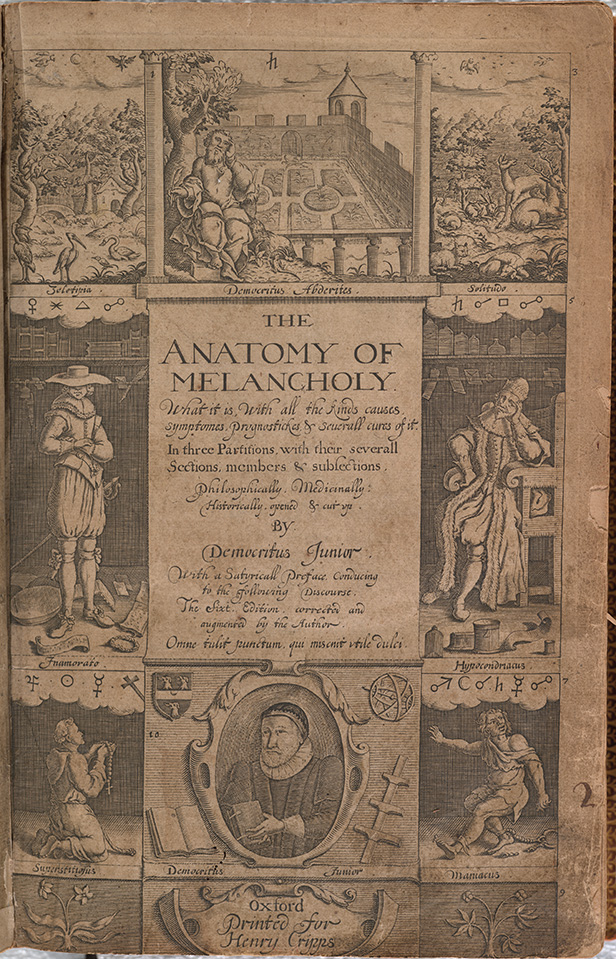”The book was so popular it went into six editions during Burton’s lifetime, and its gratified author was eager to doff
his anonymity after the first. It should have been popular. Although it gave expression to the pains of the people (always a kind of comfort), his Anatomy recounted so many sorts of follies that most of them had to have been performed or believed by others rather than ourselves; we could then happily send a hearty guffaw around the common table like a pitcher of ale, and drink to the dunces who had so deluded themselves as to think thus, do such. When the mind enters a madhouse, Burton shows, however sane it was when it went in, and however hard it struggles to remain sane while there, it can only make the ambient madness more monstrous, more absurd, more bizarrely laughable by its efforts to be rational.”

''A city merchant suffers the ill effects of his indulgence in rich food and booze. The list on his side-table documents the extent of his carnivorous greed. The effect of diet on the imagination was the source of considerable medical and critical speculation in this period. Fuseli was subject to a recurring rumour that he would eat raw pork before going to bed to stimulate his dark dreams.''
In the contemporary world, Robert Burton remains highly pertinent.A reincarnated presence could easily follow the same teail as his predecessor. What about bad diets as a cause of nervous illness? Both Burtons would have room for that. Or foul air? They could jointly bewail it. Or immoderate exercise? Or a love of gambling? Nothing unfamiliar there, nor with the desperations of imprisonment or the glooms that follow prolonged study, or the despairs impoverishment brings on. What of the consequences, both devious and direct, of festering discontents, of local resentments and historic hatreds, concerning which we have always had an apparently inexhaustible supply? Or the dangerous delusions brought on by self-love.
The Anatomy of Melancholy by Robert Burton was a prodigious, a prodigiously prodigious masterpiece of letters that took a lifetime to write. According to Dr. Ben Johnson, it was the only book that got him up early in the mornings, anxious to resume reading.
Robert Burton is not a scientist by our standards, though his ostensible aim is to throw the sweet light of reason and order upon certain aspects of human behavior. He is rather a sort of rough and ready artist who impresses with the bludgeon of volubility instead of with the refining file of Horace or the painful scrupulosity of Henry James. ”He is,” said Holbrook Jackson once, ” an artist in literary mosaic, using the threads and patches he has torn from the work of others to make a picture emphatically his own”.

Joseph Wright. 1769. ''An old man in the costume of a hermit or philosopher contemplates human bones in a lamp-lit cave, while two small men or boys dressed as pilgrims (the shells in the hats identify them as such) approach with trepidation. The exact subject of this painting is uncertain; it may relate to several different literary sources. Wright has been more concerned with creating a sense of weird mystery; note the strange discrepancy of scale between the hermit and the young men.''
Traditionally, art makes use of the raw material provided by nature; Burton’s material is artificial, man made. His approach, if not his discursive technique , brings him close to pop and collage artists who made their pictures out of soup labels and paper clippings. But a chunk of Virgil or Macrobius is somewhat more enlightening than a shred torn from a comic book or variations on a coke bottle-top. Burton contains the whole of the classical world; he makes a massive puppet show out of the great figures that, for most of us, must lie dead in the dust. These figures of antiquity are reanimated so that their wisdom may caper briefly before us. But there is only one master, the one with the strings.
Burton’s approach to his work was cumulative, additive, like that of Joyce creating ”Finnegan’s Wake” . The first edition of the Anatomy , published when he was a fresh and vigorous forty-four, was a fat enough quarto at nine hundred pages. The four editions that followed in the next seventeen years saw it swell lustily, outgrowing the quarto format and demanding the grown-up suit of a small folio. After Burton’s death in 1640, the book became a set property for the printers to do with as they liked, and the final edition of the century , a graceless folio of 1676, was a thin papered mess of typographical errors attesting the fact that an age with no relish for melancholy had begun.

Thomas Robinson.1793. ''The subject is from Thomas Percy’s poem The Hermit of Warkworth (1771). The Hermit weeps as he tells the tragic tale of Sir Bertram and Isabel to a pair of eloped lovers. In the background, Sir Bertram mourns by the side of Isabel, the women he loved but who died accidentally by his sword. The Hermit’s narrative climaxes with the revelation that he was that ill-fated hero.''
It was not until 1799, the age of the melancholy romantics, the Gothick men, and such notable antiquaries as Charles Lamb, that the ”Anatomy” came back into its own. But Lamb was unhappy about the reprint. Yet if remaining in print is a test of popularity, then Burton has remained quietly popular for the two centuries. At this moment though, his reputation seems to have suffered a certain depression, the victim of being characterized as an old fashioned book worm. However, Burton is hardly a wearisome writer; there are always new things to learn, or things so old as to become new again.
”This diet, as I have said, is not only in choice of meat and drink, but of all those other non-natural things. Let air be clear and moist most part: diet moistening, of good juice, easy of digestion, and not windy: drink clear, and well brewed, not too strong, nor too small. Make a melancholy man fat, as Rhasis saith, and thou hast finished the cure. Exercise not too remiss, nor too violent. Sleep a little more than ordinary. Excrements daily to be voided by art or nature; and which Fernelius enjoins his patient, consil. , above the rest, to avoid all passions and perturbations of the mind. Let him not be alone or idle (in any kind of melancholy), but still accompanied with such friends and familiars he most affects, neatly dressed, washed, and combed, according to his ability at least, in clean sweet linen, spruce, handsome, decent, and good apparel; for nothing sooner
cts a man than want, squalor, and nastiness, foul, or old clothes out of fashion.”
Maria Cosway. 1800. ''This design illustrates Mary Robinson’s poem The Wintry Day (1800). It is one of a set of drawings published as prints in 1804. It represents the sad fate of the poor, suffering ‘on the prison’s flinty floor’. The publisher felt he had to apologize for the artist’s exaggerated style: ‘Mrs Cosway’s designs, it must be admitted, are sometimes eccentric, but it is the eccentricity of genius’.''
During bouts of disaffection, an ascension of comparative calm and happiness might follow in taking heed of a prescription like that enumerated above. And here, in the face of health prohibitionists, is ample authority for an occasional period of intoxication. Wine is the drink, though, not spirits:
”No better physic (saith Rhasis) for a melancholy man: and he that can keep company, and carouse, needs no other medicines, ’tis enough. His countryman Avicenna, 31. doc. 2. cap. 8. proceeds farther yet, and will have him that is troubled in mind, or melancholy, not to drink only, but now and then to be drunk: excellent good physic it is for this and many other diseases. Magninus Reg. san. part. 3. c. 31. will have them to be so once a month at least, and gives his reasons for it, because it scours the body by vomit, urine, sweat, of all manner of superfluities, and keeps it clean.”
And with our wine we may smoke ”Tobacco, divine, rare, superexcellent tobacco, which goes far beyond all the panaceas , potable gold, and philosophers’ stones, a sovereign remedy to all diseases.” If our epoch considers that there is more to existence than what Edmund Burke called ”living pleasant” and not taxing ourselves with world sorrow , then we shall find in Burton enough strong intellectual meat to sustain our meditations on war, government, racism, education, law, and public morals. He has a good hit, for instance, at the American philanthropists who make their endowments in no very sincere spirit , calling their Jacobean equivalents

Henry Fuseli. Titania and Bottom. ''Titania, the queen of the fairies, has been made by her jealous husband Oberon to fall in love with Bottom, whose head has been magically transformed into that of an ass. Bottom orders her fairies to serve his whims. Peaseblossom scratches his head, Mustardseed rubs his nose, Cobweb, standing on Bottom's outstretched hand, is ordered to kill a bumblebee. The painting was commissioned by John Boydell for his Shakespeare Gallery.''
”not built precario, or by gouty benefactors, who, when by fraud and rapine they have extorted all their lives, oppressed whole provinces, societies, &c. give something to pious uses, build a satisfactory alms-house, school or bridge, &c. at their last end, or before perhaps, which is no otherwise than to steal a goose, and stick down a feather, rob a thousand to relieve ten;…”
And here is a comment on war:
”What would he have said to see, hear, and read so many bloody battles, so many thousands slain at once, such streams of blood able to turn mills, through the mad guilt of one person, or to make sport for princes, without any just cause . . . whilst statesmen themselves in the meantime are secure at home, pampered with all delights and pleasures, take their ease, and follow their lusts, not considering what intolerable misery poor soldiers endure, their often wounds, hunger, thirst, etc.,the lamentable cares, torments, calamities and oppressions, that accompany such proceedings . . .”
Burton sees bad in the world, as we all do, but he does not expect things to get any better. We are born to original sin, and all our woes stem from Adam’s fall. There is no health in us:

portion of the title page. 1638 edition. the left handed column from the top; the jealous symbolized by the moonlit garden, the lovesick personfied by a down-at-the-mouth dandy; the superstitiousby a friar telling his beads. On the RH column, the hypochondriacal personified by a bookish worrier etc..
”Number of Diseases . How many diseases there are, is a question not yet determined; Pliny reckons up 300 from the crown of the head to the sole of the foot: elsewhere he saith, morborum infinita multitudo , their number is infinite. Howsoever it was in those times, it boots not; in our days I am sure the number is much augmented:… For besides many epidemical diseases unheard of, and altogether unknown to Galen and Hippocrates, as scorbutum, small-pox, plica, sweating sickness, morbus Gallicus, &c., we have many proper and peculiar almost to every part. No man free from some Disease or other . No man amongst us so sound, of so good a constitution, that hath not some impediment of body or mind. Quisque suos patimur manes , we have all our infirmities, first or last, more or less.”
Burton would not be surprised to hear how the number has been augmented since his time. But Burton’s strength, and the ultimate cause of his cheerfulness, lies in an incapacity for disappointment. He already knows the worst. All that remains to be done is to attempt cures where cures are possible, and where there is no cure , to seek what palliatives art and nature provide. The message seems to be a relief of the fundamental melancholy that is woven into the human fabric by partaking of the infinite solace of the world; wine, venery, talk, tale telling, and most of all, books. It is in the curious wisdom of the old writers that we find the materials for the only utopia that will ever be realized: A utopia of the imagination.
To despair is stupid, to think sublunary bliss is possible is even more stupid. Burton ends his huge book with very simple maxims:
”Only take this for a corollary and conclusion, as thou tenderest thine own welfare in this, and all other melancholy, thy good health of body and mind, observe this short precept, give not way to solitariness and idleness. Be not solitary, be not idle.
SPERATE MISERI—UNHAPPY HOPE.
CAVETE FELICES—HAPPY BE CAUTIOUS.”
It is a good cautious counsel to carry through an imperfect world.





 COMMENTS
COMMENTS